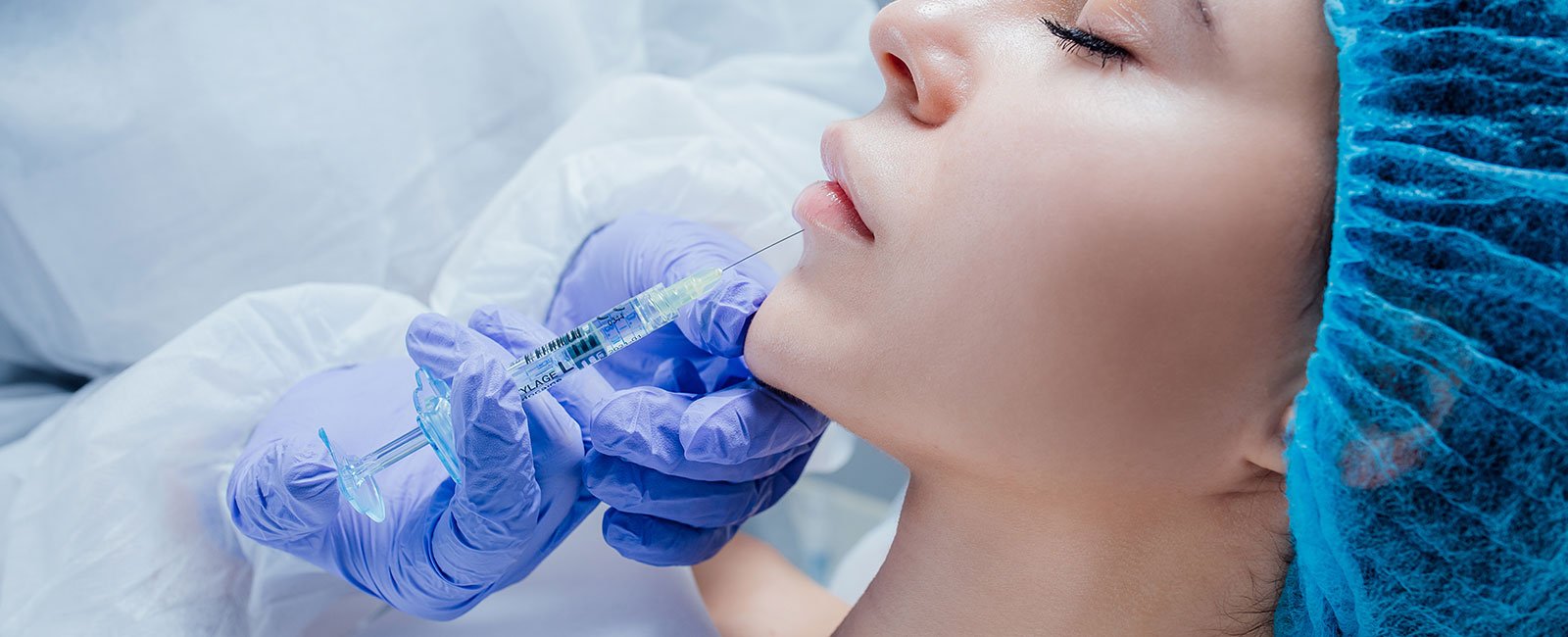Advanced Facelift Surgery in Hawaii
In Honolulu’s exclusive Infinity Life Center, patients can turn back the clock with advanced facelift surgery in paradise. Under the expert care of Dr. Michael A. Pasquale – a board-certified plastic surgeon with over 30 years of experience and fellowship training at NYU – you’re in exceptionally skilled hands. Dr. Pasquale has performed thousands of facial cosmetic procedures and is renowned for delivering natural-looking results for affluent patients across Oahu. Our comprehensive Honolulu-based aesthetic and medical practice features an in-house accredited surgical center, ensuring the highest standards of safety, privacy, and comfort for your facelift journey.
You deserve to look as young as you feel. Our team will guide you through every step – from the first consultation to your final results – so you feel informed, comfortable, and confident in your decision.
Facelift Surgery Details
| Procedure Name | Facelift (Rhytidectomy) |
| Surgeon | Dr. Michael A. Pasquale, DO – Board-Certified Plastic Surgeon |
| Anesthesia | General anesthesia or IV sedation |
| Surgery Duration | Approximately 3–5 hours |
| Setting | Outpatient surgery (home same day) at our accredited surgical center |
| Pain & Discomfort | Moderate for a few days, managed with prescribed medication |
| Downtime | 2 weeks off work and social activities (on average) |
| Recovery Milestones | Stitches out in ~1 week; most swelling/bruising gone by 2 weeks; resume exercise by ~4–6 weeks |
| Scarring | Hidden along hairline and ears; fades within months |
| Results | 10+ years younger appearance; results last 7–15 years before significant aging reappears |
What Is a Facelift?
A facelift is a surgical procedure designed to rejuvenate the face by lifting and tightening the skin and deeper tissues. During a standard facelift, sagging facial skin is redraped, and underlying structures like the SMAS (submusculoaponeurotic system) layer are tightened to restore youthful contours. The result is a smoother jawline, reduced jowls, and a firmer appearance of the cheeks and neck. Modern facelift techniques address not just loose skin but also reposition facial fat and muscle.
It’s important to understand that a facelift primarily targets the lower two-thirds of the face and neck.
Issues like sagging cheeks, deep nasolabial folds, jowls, and loose neck skin can be dramatically improved. A facelift does not inherently address the eyes or brow. For concerns such as eyelid bags or forehead wrinkles, additional procedures like a blepharoplasty (eyelid lift) or brow lift can be performed in conjunction with your facelift for more comprehensive facial rejuvenation.

Facelift Surgery Before & After Photos
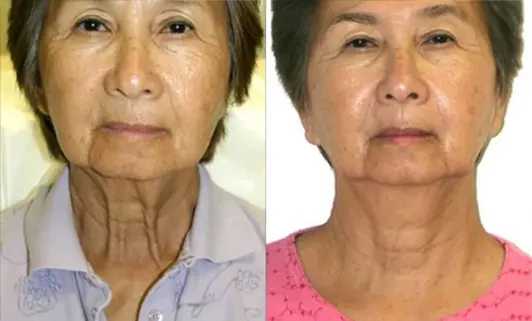
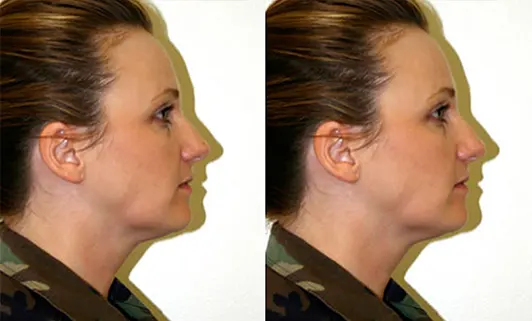
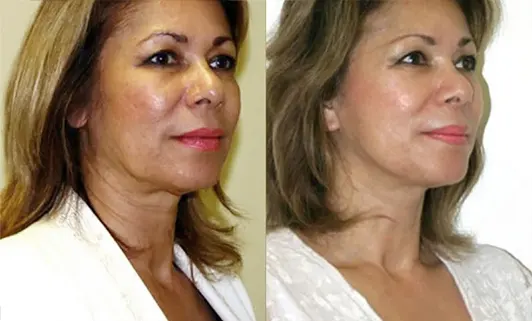
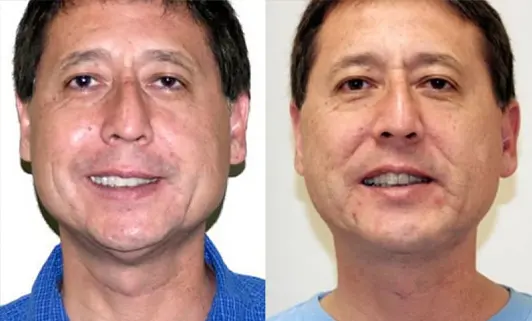
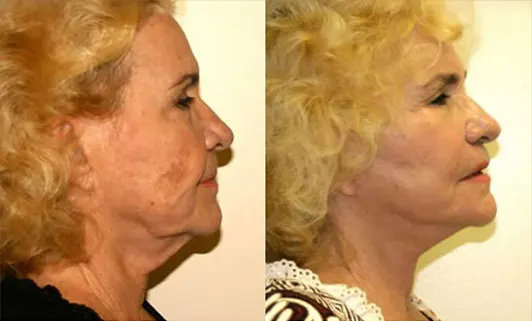
Facelift results are unique and specific to each patient. Your facelift results may vary.
Facelift Risks
Every surgical procedure carries risks such as bruising, swelling, scarring, infection, or temporary numbness. Choosing an experienced surgeon and following pre- and post-operative instructions lowers complications and supports proper healing.
Facelift Recovery
Most patients return to light activities within 1–2 weeks. Swelling and tightness improve steadily over several weeks. Following your surgeon’s guidance on rest, wound care, and activity restrictions supports a smoother recovery period.
Final Results
Refined contours and a younger appearance emerge gradually as swelling subsides. Full results are typically visible by three to six months, and improvements can last many years with good skin care and healthy habits.
Different Types of Facelifts
Facelift surgery isn’t one-size-fits-all. Various techniques target different layers and regions of the face depending on age, anatomy, and the degree of sagging. Some lifts focus on the lower face and jowls, while others improve the cheeks, forehead, or neck. Understanding these distinctions helps patients choose the most effective and natural-looking approach.
Targets mid and lower face
Tightens muscles and skin
Redefines jawline and cheeks
Hawaii’s Best Facelift Plastic Surgeon
As one of Hawaii’s most experienced and trusted facelift surgeons, Dr. Michael A. Pasquale has been performing advanced facial rejuvenation procedures for over 40 years. Board-certified and internationally recognized, he has taught his facelift techniques in Japan, China, Korea, and Malaysia. If you are searching for the best facelift surgeon in Hawaii, discover the difference decades of expertise can make.
Patients choose Dr. Pasquale for his artistry and commitment to natural, refined facelift results without an overdone look.
Schedule a ConsultIs Facelift Surgery Right for Me?
Deciding on a facelift is a personal decision that depends on your individual signs of aging, health status, and desired outcomes. Ideal candidates for facelift surgery are typically healthy non-smokers in their 40s to 70s (and beyond) who have noticeable facial aging such as:
Most patients seeking facelifts report that they want to “look like themselves, just younger and more refreshed”.
If you find that these aging changes make you look older or more tired than you feel, a facelift might be an excellent option. It’s also common for patients to try non-surgical remedies (like fillers or skin tightening treatments) first and then turn to a facelift when those no longer achieve the desired result.
Facelift Surgery Prices
At Infinity Life Center, facelift costs in Honolulu typically range from $6,000 to $20,000, not including anesthesia or facility fees; specific techniques (skin-only, SMAS, deep plane) shift the range (e.g. $6,000–8,000 for skin-only, $10,000–16,000 for deep plane). Pricing depends heavily on surgical method, surgeon’s fee, location, and “hidden” ancillary costs. Learn more here – Facelift Cost.
Natural-Looking
Facelift Results
An expertly performed facelift won’t make you look “pulled” or artificial. Dr. Pasquale’s advanced techniques ensure you still look like yourself, just more youthful and refreshed.
Long-Lasting Improvement
Results from a surgical facelift can last many years – often a decade or longer – far outlasting injectables or skin treatments.
Restore Youthful Contours
Tightens lax skin and muscles to lift the cheeks, define the jawline, and smooth out deep folds, helping you look 5–10 or more years younger.
Schedule a Consultation
Consultations allow a plastic surgeon to evaluate you and answer all the important questions that are impossible to answer otherwise, such as surgery options and surgery prices etc, All consultations are complementary and by appointment only.
Patient Analysis & Facelift Surgical Plan
In regards to face lift the face is traditionally divided into three zones by a plastic surgeon. The zones are as such in the graphic below. All of these zones must be considered to accomplish successful facial rejuvenation or improvement of the patient’s facial appearance.
Facelift Surgical Plans
A good facial surgeon should look at each aspect of your face with you and discuss possible corrective procedures and put this plan together. They should examine you closely and plan a procedure to correct each zone individually and integrally.
At your consultation, Dr. Pasquale will sit down with you and review all your options, complete with photos and drawings. This will make it very easy to understand the procedures from a technical standpoint as well as the reasons for his recommendations. Each zone of the face should be addressed and a plan to make corrections developed for your facelift procedures.
Brow Lift Combined with Facelift
A brow lift is sometimes performed with a facelift to rejuvenate both the upper and mid-face in one procedure. When the forehead shows deep lines or drooping brows, combining the two creates a balanced, natural lift with one recovery period. Performed by Dr. Michael A. Pasquale in Honolulu, Hawaii, this combined approach smooths the forehead and raises the cheeks and jawline for more complete facial rejuvenation.
When to Combine Brow Lift & Facelift
Patients with forehead creases, sagging brows, or drooping jowls benefit from addressing both areas together. Treating only the lower face can leave the upper face looking aged, while a combined lift restores overall harmony.
Technique Overview
Small incisions are placed along the scalp and hairline to tighten underlying muscles and remove excess skin. The result is a smoother brow, lifted cheeks, and a refreshed facial contour. Most patients return to normal activities within two weeks. Swelling and bruising are temporary. Combining the two procedures minimizes total downtime compared to staging them separately.
Second Facelift (Revision Surgery)
A second facelift, or revision facelift, refreshes results from an earlier surgery when signs of aging return. Most facelifts last 7–15 years, depending on genetics, skin quality, and lifestyle. Aging continues naturally, so a second lift helps restore tone and definition.
Surgical Considerations
A revision facelift is more complex than the first procedure due to the presence of scar tissue and thinner, less elastic skin. The surgeon must carefully work through previous incision lines—usually placed along the original hairline—to locate safe dissection planes. Despite these challenges, experienced surgeons can redrape and tighten the facial tissue to achieve natural results. Minor hair thinning near incision lines may occur.
Non-Surgical Alternatives
Not all patients require another full surgery. In some cases, fat transfer, dermal fillers, or non-surgical skin tightening treatments can refresh facial contours and improve tone without surgery. These options may extend the results of a previous facelift and postpone the need for a second operation.
Facelift with Necklift
A neck lift combined with a facelift offers the most comprehensive rejuvenation of the lower face and jawline. While a facelift tightens sagging facial tissue, a neck lift refines the contours beneath the chin and along the neck, eliminating lax skin and banding that often reveal age. Because both procedures share nearly identical incision sites, performing them together maximizes results with a single recovery period. This combination ensures a smooth, youthful transition from face to neck—creating balanced, natural-looking rejuvenation.
A traditional facelift already uses the same incisions as a neck lift, minus a small incision under the chin.
A neck lift combined with a facelift offers the most comprehensive rejuvenation of the lower face and jawline. While a facelift tightens sagging facial tissue, a neck lift refines the contours beneath the chin and along the neck, eliminating lax skin and banding that often reveal age.
Facelift Surgery FAQ
A facelift, medically known as a rhytidectomy, is a surgical procedure to rejuvenate the face by reducing sagging skin and wrinkles. It aims to give a more youthful appearance by reshaping the lower half of the face.
Ideal candidates are generally those experiencing signs of aging like sagging skin, deep wrinkles, or jowls, usually in their 40s to 70s. Good candidates are healthy, non-smokers, and have realistic expectations.
There are several types, including traditional facelifts, mini-facelifts, and mid-face lifts. Each varies in invasiveness and focuses on different areas of the face, tailored to individual aging concerns.
Expect a detailed discussion about your aesthetic goals, medical history, and a physical examination. Your surgeon will explain different facelift options and what results you can realistically expect.
Preparation involves stopping smoking, avoiding certain medications, and getting lab tests as instructed. Ensure you have someone to drive you home post-surgery and help during your initial recovery.
Most people can return to normal activities within 2 weeks, but complete healing may take a few months. Initial swelling and bruising are common but subside gradually.
Common surgical risks include bleeding, infection, and anesthesia reactions. Specific to facelifts are risks of nerve injury, asymmetry, and scarring. Choosing an experienced surgeon minimizes these risks.
A facelift can turn back the clock, but it doesn’t stop aging. Results typically last 10 to 15 years, depending on your skin quality, age, and lifestyle factors like sun exposure and smoking.
Incisions are typically made along the hairline or natural skin folds to minimize visibility. Scars are generally well-hidden and fade significantly over time.
A mini-facelift targets mild to moderate signs of aging and involves smaller incisions and a shorter recovery time. It’s less invasive than a full facelift, which addresses more significant aging signs.
A facelift removes excess skin and tightens underlying tissues, but it doesn’t change your skin’s texture. Complementary treatments like laser resurfacing or chemical peels can improve skin quality.
Facelifts are usually performed under general anesthesia or intravenous sedation, ensuring you are comfortable and pain-free during the procedure.
Look for a board-certified plastic surgeon with extensive experience in facelifts. Review their portfolio, read patient reviews, and ensure you feel comfortable with their approach and communication style.
Costs vary based on the surgeon’s experience, the procedure’s complexity, and geographic location. It typically includes the surgeon’s fee, facility costs, and anesthesia fees. Get a detailed estimate during your consultation.
Non-surgical options like fillers, Botox, and laser treatments can address some signs of aging but won’t achieve the same results as a surgical facelift, especially for moderate to severe aging signs.
Yes, facelifts are often combined with other procedures like eyelid surgery or brow lifts for a more comprehensive rejuvenation.
Follow your surgeon’s instructions for care, which typically include keeping the skin clean, applying prescribed ointments, and avoiding sun exposure. Good skincare and a healthy lifestyle will help maintain your results.
Signs include sagging skin around the cheeks and jawline, deep wrinkles, and loose skin on the neck. A facelift could be an option if these changes bother you and you desire a more youthful appearance.
Have a frank discussion with your surgeon about your goals and listen to their professional assessment. Understand that a facelift aims for a refreshed, natural-looking you, not a total transformation.
If you’re not happy with the outcome, discuss it with your surgeon. In some cases, minor touch-ups can be done. It’s important to have realistic expectations and understand that perfect symmetry or reversing all signs of aging is not achievable.


